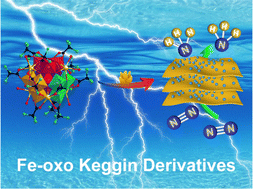Polyoxometalate-derived bimetallic catalysts for the nitrogen reduction reaction†
Abstract
Facile design of low-cost and efficient electrocatalysts is one of the urgent problems to be solved for the electrocatalytic nitrogen reduction reaction (NRR) in a mild environment. Among them, polyoxometalates (POMs) are promising catalysts due to their advantages of abundant transition metal sites, defined structures, and excellent redox ability. Here, we report the use of a molecule-to-particle strategy for fabricating bimetallic composites as NRR catalysts by utilizing iron–oxo Keggin as the precursor. This bimetallic POM-derived Bi/BiClO/Fe3O4-600 composite offers ample dispersed metal sites, a porous structure and enhanced conductivity. In addition, the problem of easy hydrogen evolution of Fe species (Fe3O4) can be effectively suppressed due to the hydrogen-repellent properties of Bi species (Bi/BiClO). In 0.1 M KOH, Bi/BiClO/Fe3O4-600 achieved an ammonia yield of 12.82 μg h−1 mg−1cat. with a faradaic efficiency of 15.22% at low voltage (−0.1 V vs. RHE). The bimetallic composite also demonstrated excellent stability and reproducibility during the whole electrocatalytic NRR process. Such a molecule-to-particle strategy expands possibilities for constructing efficient well-defined metallic nanocomposites for catalytic fields.

- This article is part of the themed collection: 2023 Materials Chemistry Frontiers HOT articles


 Please wait while we load your content...
Please wait while we load your content...